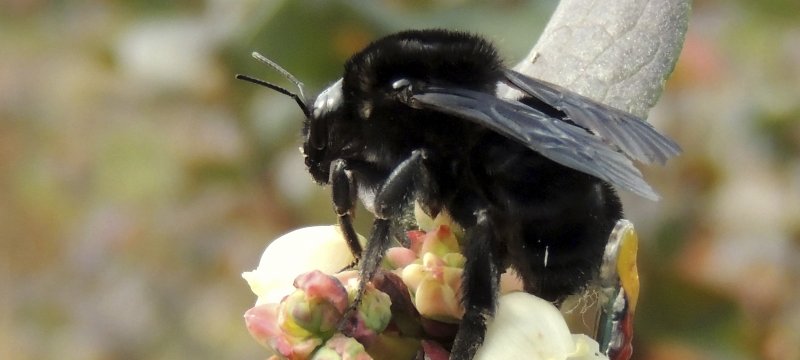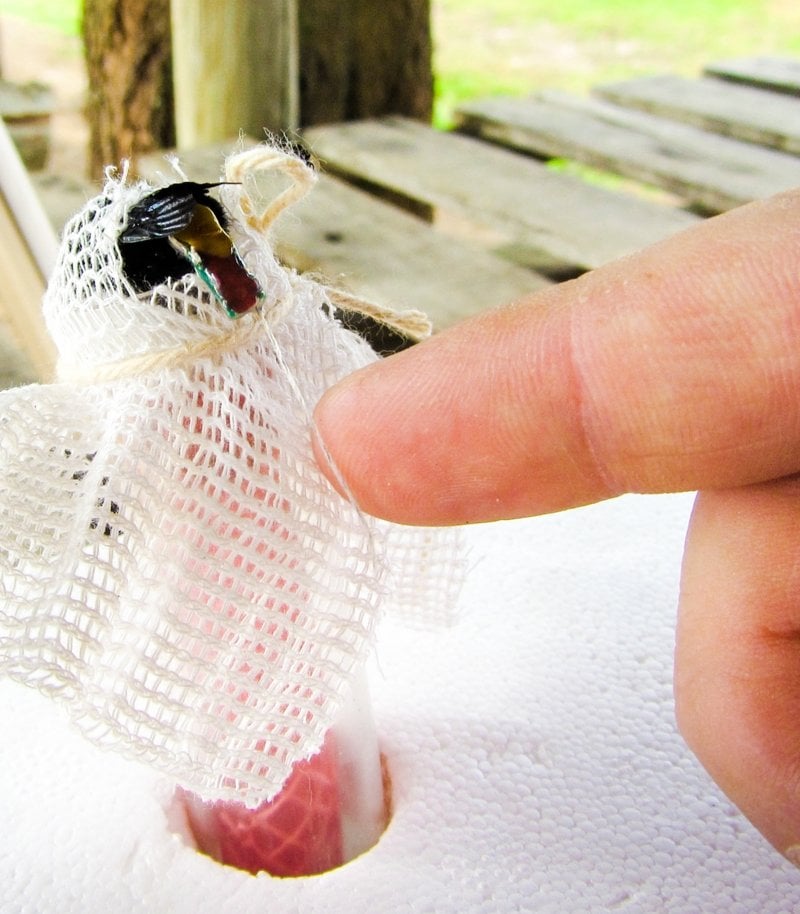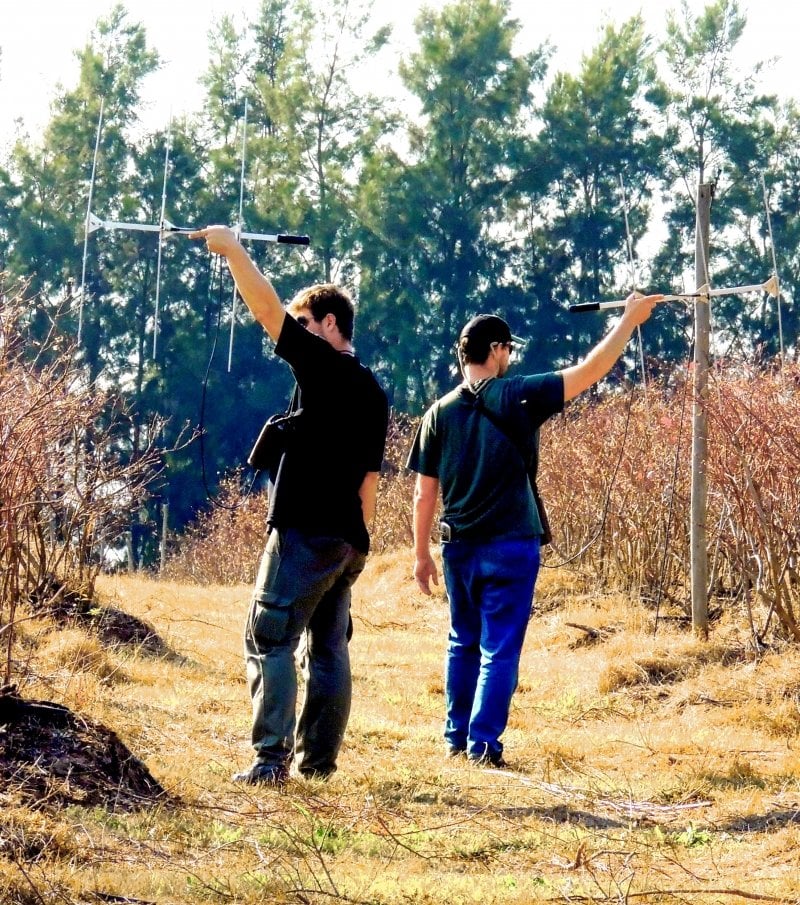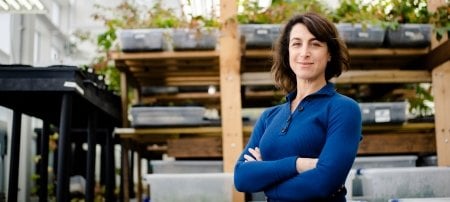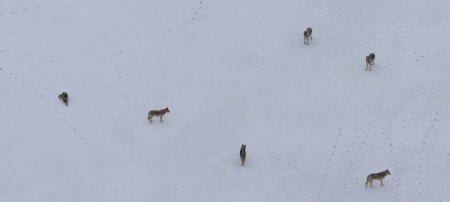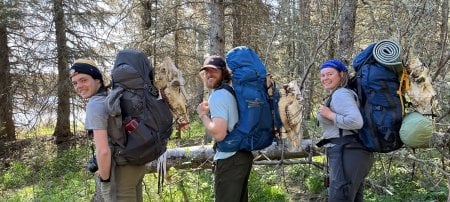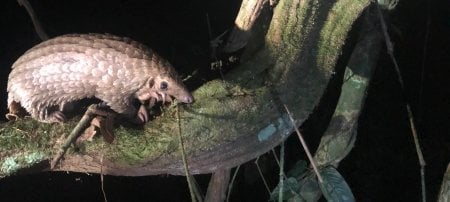Researchers rigged radio transmitters on 17 bumblebee queens, tracking them through blueberry fields in Argentina to better understand how wild pollinators support agriculture.
Affixing transmitters to bee abdomens is no job for the impatient or unsteady. Finding a quick, efficient method required three months of tests and a myriad of glue combinations with varied drying times.
"The practice started with some unfortunate workers who, after a couple of failures and stung hands, made me change my mind," says project lead Pablo Cavigliasso of Instituto Nacional de Tecnología Agropecuaria (INTA), Argentina's national agricultural technology institute. "Then we designed a transparent plunger system to see how the [bee] individuals are accommodated before immobilizing them and, in the style of a surgical operation, the fabric is cut in the place where the transmitter will go and we continue being very careful not to glue the abdominal area excessively."

About 35 percent of global food production and 70 percent of economically significant crops rely on insect pollination. But wild pollinator populations are decreasing. The bumblebee Bombus pauloensis pollinates South American blueberries and an international team of researchers set out to follow them through fields in Argentina. They found that bumblebee nests are made to maximize food sources over the span of a queen's life. The team plans to continue collaborating on pollinator ecology studies. Image credits: Colin Phifer, Pablo Cavigliasso.
In about 15 minutes, with the glue dry and transmitter operation confirmed, Bombus pauloensis queens can go about their single-season life, pollinating blueberry bushes and scoping out the perfect nest with the best view.
BIOPIRE at Michigan Tech
Kathy Halvorsen, associate vice president for research development at Michigan Tech, was the Principal Investigator (PI) of the BIOPIRE project, a six-year bioenergy research initiative that investigated ways to meet global energy challenges while mitigating climate change. "BIOPIRE focused on understanding bioenergy sustainability," Halvorsen says. "The pollinator project was essential to understanding the ecological dimensions of bioenergy sustainability and had strong ties to socioeconomic sustainability in that pollinators are essential to regional agriculture in all our study sites." Next steps include a few more publications and new collaborations.
Wildflowers bloom in old fallow fields. Orange trees in adjacent citrus groves scent the air. Warm days and big storms come quickly in these lush blueberry fields, buffered by pine stands and eucalyptus wind breaks. "It is a beautiful part of Argentina," says Michigan Tech graduate Colin Phifer ‘17, now a postdoc at the Environmental Protection Agency (EPA) and a part-time instructor at Lane Community College, who moved to Argentina with his family for five months during the study. "The landscape was mostly owned by INTA, so we could work there without difficulty. The surrounding fields were owned by companies who were also supportive of this project and let us walk and drive on their land."
INTA focuses on sustainable innovation that benefits the country's agricultural base: farmers, farming communities, and industry. Michigan Tech collaborated with INTA through BIOPIRE, a research project funded by the long-running National Science Foundation's Partnerships for International Research and Education (PIRE) program. The PIRE initiative spans social, engineering, and natural sciences in six countries across the Americas.
The bee-tracking project's overarching goal—to learn how pollinators negotiate in human-altered spaces—rapidly morphed into the nitty-gritty of figuring out how to gently, firmly, and temporarily affix tiny transmitters to the abdomens of highly annoyed bumblebees (unlike honeybees, bumbles can sting more than once). Once attached, the researchers tracked the queens' movements on foot and by vehicle to learn how their preferences for home and food changed throughout their annual life cycle.
"We didn't know what would work. So everything was new," Phifer says. "We had to adapt to the challenges and learn from the experiences."
Right Researchers, Right Place, Right Time
Conducted in Argentinian blueberry plots and surrounding environs, the study, "Spatio-temporal dynamics of landscape use by the bumblebee Bombus pauloensis (Hymenoptera: Apidae) and its relationship with pollen provisioning," illustrates community development at its most meta. From the eusocial hives nurtured by bumblebee queens who, unlike honeybees, live just a season, to intertwined environmental and agricultural ecosystems, to a network of established researchers forming cross-continent collaborations while mentoring emerging researchers in their disciplines.
"This is the first for this species, the first to be done in a working agricultural blueberry field, and the first to link pollen resources with travel in real time."
Led by Cavigliasso, with Phifer and BIOPIRE ecosystem subteam leader David Flaspohler of Michigan Tech's College of Forest Resources and Environmental Science (CFRES), the findings were published in the open-access journal PLOS ONE in July 2020. The research team also included Erika Adams from CFRES, INTA researchers Gerardo Gennari and Julian Licata, and Institute of Regional Ecology (IER)-CONICET researcher Natacha Chacoff.
The team found that a bumblebee queen changes food preferences throughout her life, conducting reconnaissance and strategically establishing her nest to accommodate changing needs during her life cycle. The team's transdisciplinary work demonstrates how diversified agroecosystems better support wild pollinators, maximizing the virtuous circle of relationships that benefit the land, its seed bank, and the various communities—including humans—who depend on it.
The Not-So-Secret Life of Bees
It's no secret that the world's food supply relies on pollinators—about 35 percent
of global food production and 70 percent of economically significant crops rely on
insect pollination to some extent. But many wild pollinator populations are declining.
When it comes to pollination, bumblebees are the royal standard, playing a crucial
role for both agricultural crops and natural ecosystems. Unlike honeybees, bumblebees
"buzz pollinate."
The action, like revving a car engine in neutral or agitating a salt shaker, dislodges
pollen from crevices in flower anthers, making bumbles more effective pollinators
for crops—including peppers, tomatoes, eggplants, blueberries, and cranberries. Other
differences: These big bees are more active at cooler temperatures than honeybees
and other smaller-bodied bees; they live in smaller colonies in below-ground hives;
and they don't store large amounts of honey, making a diverse, all-season diet essential
for their survival.
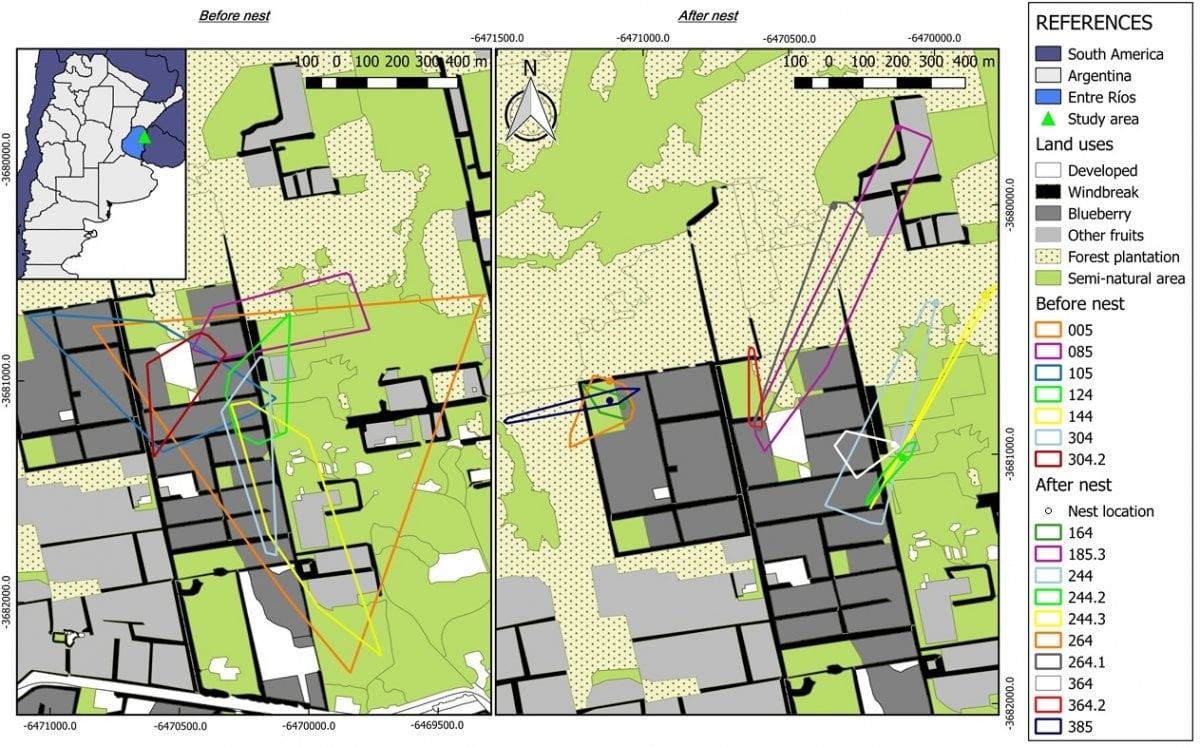
The research team's before and after mapping shows how the queens shifted foraging patterns once nests were established.
Image description: References: Land uses, LU categories included in the landscape use analysis; Before and After nest, in each case, the code used identified each individual corresponding to the radio frequency of ATS Series A2412 transmitter. References Key: South America, Argentina, Entre Rios. Study area. Land Uses: Developed, windbreak, blueberry, other fruits, forest plantation, seminatural area. Before nest: 005, 085, 105, 124, 144, 304, 304.2. After nest. Nest location: 164, 185.3, 244, 244.2, 244.3, 264, 264.1, 364, 364.2, 385
Phifer, who has studied pollination relationships from the plant's perspective, says Cavigliasso's keen entomology knowledge was an other-side-of-the-coin perspective that pushed the general concept of the research into a specific approach. The research team chose the Bombus pauloensis species for practical reasons. Widely distributed on the continent, these bumblebees specialize in pollination of the genus Vaccinium, to which blueberries belong. "Pablo loves the insects," Phifer says. "He was able to think like a bee." The duo's complementary skills encouraged them to grow alongside their research.
"We met in Argentina doing some biodiversity sampling of bees from the native Espinal entrerriano forest. We had never worked together and neither spoke the other's language well. It was a very fun and tiring six months," says Cavigliasso, who contextualized the telemetry study with the palynological (pollen identification) information on Bombus pauloensis in one of his doctoral dissertation chapters. He adds: "From that hybrid came this beautiful work team," which worked like a hive itself—Phifer, Cavigliasso, Adams, and the INTA crews played tag with bees in the blueberries; Cavigliasso and Phifer joined their advisers, Chacoff from IER-CONICET and Flaspohler from Michigan Tech, to make ecological connections; and Halvorsen connected them all to the whole BIOPIRE project, spanning six countries and more than 100 other researchers.
"I often think there are three stages of research: the one you propose, the one you find in the fieldwork, and the one you find when you do your data analysis. For us, each stage looked different and we had to adapt to it."
Follow the Foraging Queens
Identification was straightforward. "Blueberry is a winter crop, so there are few other species of similar wild bees out. Also, they look like flying bears," Cavigliasso says.
Distinguishing the queens was also self-evident. "At the time we were collecting bees, it was mostly only the queens that were out. This is before they have made a nest and have workers. They're big bees—hard to miss!" Phifer says. Size mattered: Bombus pauloensis queens can carry more than 80 percent of their weight during foraging flights, so outfitting them with 0.2-gram transmitters, about the weight of nine grains of rice, wasn't a problem.
How does one go about capturing a queen without hurting her or getting stung? "It's like the old joke, ‘How do porcupines make love? Very carefully,'" says Phifer. "With an entomology net, you can quickly set the bee and then gently ‘encourage' it into the plastic vial."
The trial-and-error process involved a few stings, adds Cavigliasso. "We tried entomological aspirators first," he says. "The nets were more efficient but the stings were more frequent—they are not pleasant at all."
The work is fiddly and a royal pain, although it came with the occasional berry reward, and the tracking itself was no walk in the park.
There were fences, windbreaks, ditches, and irrigation ponds to contend with in blueberry plots, along with the natural and human-made obstacles in adjacent habitats and production systems. Two-person monitoring teams—one driving a pickup, the other with the receiver, began each day looking for a queen near the last point she'd been marked at the previous day. "We stayed with her until we lost the trail, marking GPS points every two to five minutes. For this you have to run, jump fences, and mark points at a trot, get into small thorny savannas—and even look at your target as it flies in front of you over an irrigation pond that you cannot cross," says Cavigliasso.
"The bees could always fly faster than we could go," Phifer says.
"The most exciting thing was the first successful flight and the first relocation. We couldn't believe it. I think Colin ran after her through the lines of blueberry plants and got lost in the trees."
Researchers found that newly emerged queens in search of nesting sites moved through larger areas, mostly within the blueberry fields. Once their nests were established, they navigated to the periphery of the agricultural plots, seeking wildflowers and other blooming plants in undeveloped areas—resources to nourish the growing worker colony following the blueberry bloom. Documenting this change in home range and diet preferences over a queen's life cycle adds to the body of knowledge related to both bee activity and how land management practices can foster their preservation and protection.
A Community Polyculture Model for More Than Bees
The first study to track queen bumblebee movements in an agricultural setting and relate movement changes across time and space with pollen resources also illustrated that successful research is not a monoculture. Despite the stings and obstacles, Cavigliasso says the most daunting aspects of the project came long before the queens were netted, rigged, and tracked. "I think the most challenging thing was organizing the logistics to start the study. There were many things that we did not know if they were going to work out and we had high expectations. Once in the field, things were resolved quickly and we knew how to improvise very well."
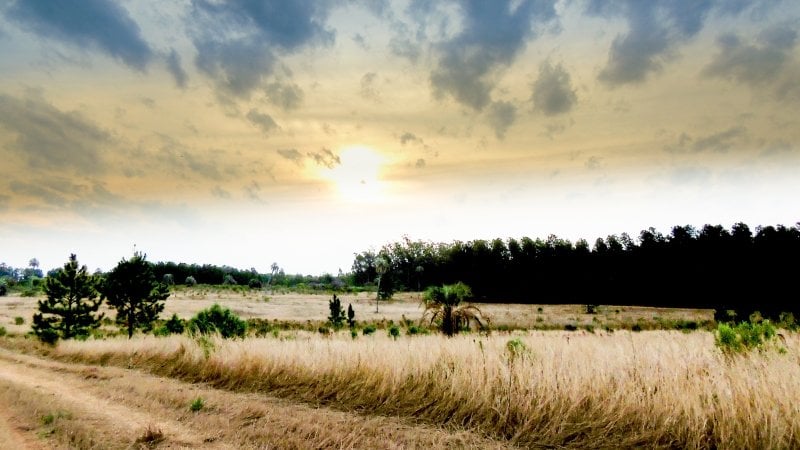
Just as the queen bumblebees tap into new resources as needed to nurture the next queens and sustain the community, this international network of researchers stand ready to provide scholarly intellectual resources for the benefit of future generations. The ‘E' in PIRE and BIOPIRE, Flaspohler reminds, stands for education. Providing a career development framework for up-and-coming researchers was part of the mission.
"This project is a great example of the fruit bearing fruit of that relationship," Flaspohler says.
Efforts toward that end did not stop with the initiative. Like the holistic process of agro-culture, which considers all the coexisting components within an agricultural environment, research collaborations continue to come full circle. "BIOPIRE built on and greatly expanded a core of researchers with a long history of working together across disciplines," Michigan Tech's BIOPIRE lead Halvorsen says. "This ensured that we had a core group experienced in transdisciplinary research who came to the project with deep trust in each other and a full understanding of the challenges of working together in a project like this. We were able to capitalize on this experience and relationships to carefully add in new researchers who brought the expertise and social skills vital to large, complex project success where working together requires a lot of patience and commitment. These are lessons to keep in mind whenever people are putting together large, complex research teams with disciplinary diversity."
"One of the wonderful outcomes of this six-year project was seeing students, postdocs, and junior faculty gain confidence and move up into leadership positions within BIOPIRE and in other parts of their career."
Research relationships sustained and established while chasing queen bees in blueberry fields are one way to continue the conversations and collaborations of the future, on which no less than the fate of the world rests. Like the bumblebees, researchers carry a mighty weight. But responsibility is also collectively shared among world citizens.
Preserve and Protect Bumblebees
Whether the vista is a South American blueberry plot or Michigan's lowbush blueberry crop, there are steps anyone can take in their own backyard to reverse the worldwide decline in bumblebee populations. Michigan Tech alumna Katie Hietala-Henschell '10 '13 holds a BS in applied ecology and a master's in forest ecology and management, and works with bumblebees and other pollinators impacted by habitat loss, pesticide use, and lack of seasonal food
"It's a very interesting study, and more information about queen bumblebees is needed," says Hietala-Henschell, who serves on the New York Natural Heritage Program's Empire State Native Pollinator Survey Advisory Board. She also worked for four years with the Xerces Society, which provides accessible resources while also doing the behind-the-scenes heavy lifting, such as preparing petitions to get species, like the rusty patched bumble bee, listed under the Endangered Species Act. "I would recommend anyone interested in bumblebee conservation and other invertebrate conservation to check out their free resources, including the Xerces Society YouTube channel, and consider becoming a member," she says.
Here are other steps individuals can take:
- Limit pesticide use, especially neonicotinoids (systemic insecticides) that do not differentiate between pests and beneficial insects. Don't use herbicides that reduce food resources.
- Provide continuous floral resources during the season. Bumblebees don't store large amounts of honey, like honeybees; they're at higher risk if floral resources aren't available during the season. Consider plantings that provide flowers for early and late season—the two most vulnerable times when the queens' survival is essential for colonies to establish. Plant early-blooming flowers and shrubs/trees for newly emerged queens and late bloomers as resources for the new queens looking to overwinter (they need to build up fat reserves to survive).
- Diversify your lawn. Plant native species if you're able to convert part of it to include wildflowers, or flowering shrubs and trees. If you can't diversify, consider mowing less often to allow clover and other valuable flowering plants to mature.
- Leave wild areas for nesting habitats (all the bees in the pollinator study were found in seminatural areas). One of the easiest ways: Let the leaves lie where they fall—or consolidate them in a corner of the garden or yard—rather than bagging and removing.
- Offer potential nest sites by adding rock or brush piles near your floral resources. Bees aren't vigorous diggers, and prefer loose substrate. They may repurpose holes in the ground left by other animals, or occupy old foundations. Providing potential homes near foraging areas saves energy by reducing how far they have to travel to meet their needs.
- Take a fresh look at weeds. Species like dandelion and clover are important early-season resources for newly emerged queens. Let them bloom in your yard to help your local queens establish successful nests.
- Encourage friends, family, and neighbors to plant flowers, creating resource corridors and networks that nurture bumblebees. They'll thank you for the favor by helping flowers bloom faster.
- Participate in citizen science by joining Bumble Bee Watch or iNaturalist, contributing to the current understanding, distribution, and status of bumblebee species. Huskies, and other students, faculty, and staff of higher learning institutions interested in pollinator conservation and advocacy can also be involved in Bee Campus USA.
Michigan Technological University is an R1 public research university founded in 1885 in Houghton, and is home to nearly 7,500 students from more than 60 countries around the world. Consistently ranked among the best universities in the country for return on investment, Michigan's flagship technological university offers more than 185 undergraduate and graduate degree programs in science and technology, engineering, computing, forestry, business, health professions, humanities, mathematics, social sciences, and the arts. The rural campus is situated just miles from Lake Superior in Michigan's Upper Peninsula, offering year-round opportunities for outdoor adventure.
